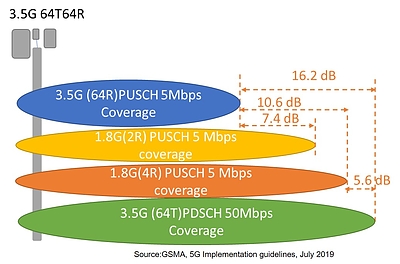TDD TMA - A viable solution to the 5G uplink challenge
"5G has been widely deployed worldwide in the 3.3-3.8 GHz IMT range, including China, Europe, the Middle East, Japan, Korea. When 5G NR is deployed in these bands, the uplink coverage is expected to suffer from high path loss and penetration loss, which leads to poor user experience, particularly for TDD frame structure with less uplink slots. Although some 5G technologies like multi-antenna transmission could mitigate the issue to some extent, the coverage performance gap between LTE and NR still exists".
(Source: GSMA 5G SA Option 2 Implementation guidelines).
 The gap is about 16 dB between the Downlink and Uplink. Using solutions such as Carrier Aggregation, Supplimentary Uplink and Decoupling will help, however there will still be about 5 dB missing. Using a TDD TMA will typically improve the uplink with 2+ dB resulting in increased downlink thoughput and reduced delay in Time to Content.
The gap is about 16 dB between the Downlink and Uplink. Using solutions such as Carrier Aggregation, Supplimentary Uplink and Decoupling will help, however there will still be about 5 dB missing. Using a TDD TMA will typically improve the uplink with 2+ dB resulting in increased downlink thoughput and reduced delay in Time to Content.
The TDD TMA for 5G systems addresses the issues of uplink and downlink imbalance by amplifying the uplink signal. This leads to a better signal to noise ratio, allowing a higher coding scheme to be used, thereby increasing the throughput and reduce delays in Time to Content.
The Kaelus TDD TMA features a unique design for fast Tx/Rx switching maintaining high data throughput.
The TDD TMA portfolio includes solutions for 2.3, 2.5, 2.6 and 3.5 GHz systems.